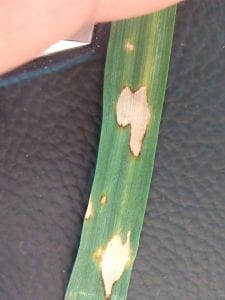Contents
Alfalfa Weevil
Alfalfa weevil is at alert status. There are many fields over threshold in western NY. The larvae were at 2nd and 3rd instar. When you view the degree-days for alfalfa weevil most of the state is in the larval feed stage. The only exception is Northern NY where eggs will hatch soon. The best way to control alfalfa weevil is to harvest the field.
For more on alfalfa weevil please view the link to management information:
https://cals.cornell.edu/field-crops/forages/insects-forage-crops/alfalfa-weevil
Alfalfa Weevil Degree Day Accumulations from March 1 to May 23
| Weather Station Location | Alfalfa Weevil-Degree Days | Life Stage |
| Arkport | 295 | Larvae Feeding |
| Bergan | 331 | Larvae Feeding |
| Ceres | 283 | Larvae Feeding |
| Conesus Lake | 331 | Larvae Feeding |
| Corwin | 301 | Larvae Feeding |
| Gansevoort | 380 | Larvae Feeding |
| Geneva | 356 | Larvae Feeding |
| Highland | 447 | Larvae Feeding |
| Ithaca | 391 | Larvae Feeding |
| Kinderhook | 378 | Larvae Feeding |
| Lafayette | 377 | Larvae Feeding |
| Laurens | 267 | Larvae Feeding |
| Malone | 232 | Egg laying |
| Northport | 450 | Larvae Feeding |
| Peru | 253 | Egg laying |
| Red Hook | 405 | Larvae Feeding |
| Versailles | 370 | Larvae Feeding |
| Watertown | 264 | Egg laying |
Alfalfa Weevil Life stage Development
Growing Degree Days for peak (50%) occurrence of stage
| Stage of Life Cycle | Degree Days * |
| eggs hatch | 280 |
| Instar 1 | 315 |
| Instar 2 | 395 |
| Instar 3 | 470 |
| Instar 4 | 550 |
| Cocooning | 600 |
| Pupa | 725 |
| Adult Emergence | 815 |
*48 degree F base temperature
Fusarium head blight commentary, May 19, 2022
Gary Bergstrom, Professor, Plant Pathology and Plant-Microbe Biology, Cornell University
Now is the time to make a critical fungicide spray decision on winter malting barley. Winter barley in New York has either reached full head emergence or will do so in the next few days The Fusarium Risk Assessment Map (http://www.wheatscab.psu.edu/ ) currently indicates a low risk of Fusarium head blight (FHB) across the state, but this could change with rain showers and thunderstorms in the forecast. Maximal suppression of FHB and grain contamination by deoxynivalenol (DON) mycotoxin results when fully emerged heads of winter malting barley are sprayed with DMI (FRAC Group 3) containing fungicides Caramba, Prosaro, or Miravis Ace (latter includes FRAC Group 7 fungicide). A heads-emerged spray with these fungicides also protects upper leaves against fungal leaf blotches, powdery mildew, and rusts. Foliar sprays of any of these three products up to seven days after head emergence may still result in significant FHB and DON suppression.
Winter wheat development in New York ranges from flag leaf just visible to boot stage and is expected to initiate flowering over the next two weeks; the crop is further ahead in the Hudson Valley than in western New York. The DMI (FRAC Group 3) containing fungicides Caramba, Prosaro, or Miravis Ace (latter includes a FRAC Group 7 fungicide) are the most effective fungicides for suppression of Fusarium head blight (FHB) and deoxynivalenol (DON) mycotoxin contamination when applied at flowering (emergence of yellow anthers on heads). A flowering application of these fungicide products should be based on FHB risk as well as the risks of powdery mildew, rusts, and fungal leaf blotches in the upper canopy based on scouting of individual fields. There is an application window of approximately 7 days from the beginning of flowering in which reasonable FHB and DON suppression can be expected. Check the Fusarium Risk Assessment Tool (http://www.wheatscab.psu.edu/ ) and your local weather forecast frequently as your winter wheat crop approaches heading and flowering.
Alternaria leaf spot
Mike Hunter reports finding Alternaria leaf spot in wheat in southern Jefferson County. This was found a few years ago and is a new disease in NYS. Here is an article that was prepared on this new disease: https://blogs.cornell.edu/whatscroppingup/2017/06/02/alternaria-leaf-spot-of-wheat-in-new-york/
Black cutworm and True armyworm
There have been more intense catches for black cutworm and true armyworm with our field corn pheromone-trapping network in western and northern NY. You will see leaf-feeding for black cutworm and some cut plants by now with the early flights in late April. For true armyworm, the typical symptoms are feeding on the edge of the leaf and working their way to the midrib. For management information on both insect pests, please view the following page.
Black Cutworm
https://cals.cornell.edu/field-crops/corn/insects-corn/cutworms
True Armyworm
https://cals.cornell.edu/field-crops/corn/insects-corn/armyworms
Interactive Map with Black Cutworm and True Armyworm Moth Flight Captures
Black Cutworm Degree Day Accumulations from March 1 to May 16
| *Location for Intense Catches |
Black Cutworm (Base 50) |
Life Stage |
|
Seneca Falls Seneca County April 26 25 Moths Caught |
208 |
Leaf Feeding 1st-3rd Instar |
|
Avon Livingston County May 12 23 Moths Caught |
158 |
Leaf Feeding 1st-3rd Instar |
|
Rush Monroe County May 15 39 Moths Caught |
101 |
Laying Eggs 1st-3rd Instar |
|
Hounsfield Jefferson County May 16 25 Moths Caught |
68 | Laying Eggs |
|
Casterland Lewis County May 16 23 Moths Caught |
68 | Laying Eggs |
|
Canton St Lawrence May 16 37 Moths Caught |
68 | Laying Eggs |
|
Seneca Falls Seneca County May 17 23 Moths Caught |
73 |
Laying Eggs |
*Intense Catch is over 15 moths in a week.
True Armyworm Degree Day Accumulations from March 1 to May 16
| *Location for Intense Catches |
True Armyworm (Base 50) |
Life Stage |
|
Seneca Falls Seneca County April 26 29 Moths Caught |
208
|
Leaf Feeding |
*Intense Catch is over 15 moths in a week.



